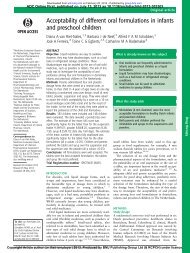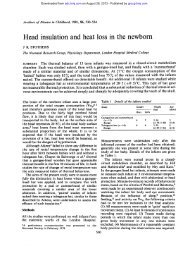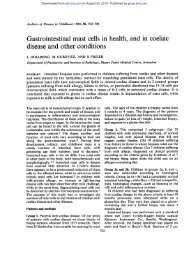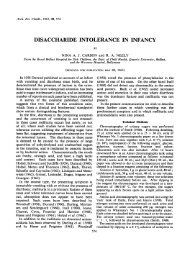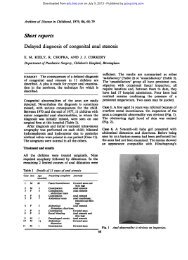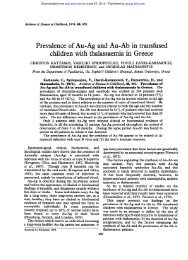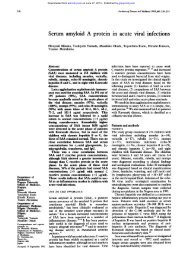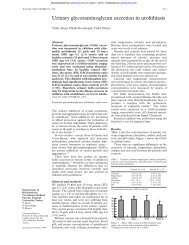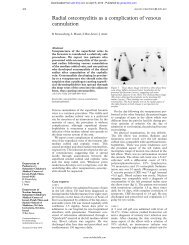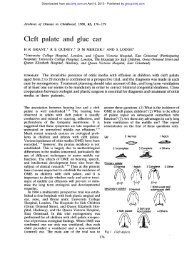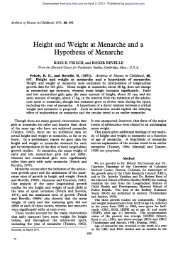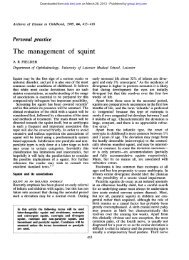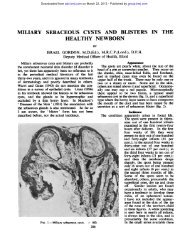Accidental administration of Syntometrine in adult dosage to the ...
Accidental administration of Syntometrine in adult dosage to the ...
Accidental administration of Syntometrine in adult dosage to the ...
You also want an ePaper? Increase the reach of your titles
YUMPU automatically turns print PDFs into web optimized ePapers that Google loves.
generalised convulsions and received diazepam 5 mg,<br />
phenobarbi<strong>to</strong>ne 45 mg, and paraldehyde 0 5 ml.<br />
At <strong>the</strong> onset <strong>of</strong> convulsions <strong>the</strong> plasma calcium,<br />
magnesium, urea, and electrolytes and <strong>the</strong> blood<br />
glucose levels were all normal.<br />
No ur<strong>in</strong>e was passed until 19 hours and by 48<br />
hours her weight was 180 g above birthweight,<br />
with gross oedema, and serum Na 102 mmol/l.<br />
Fluid <strong>in</strong>take (10% glucose) <strong>in</strong> <strong>the</strong> first 24 hours was<br />
60 mi/kg and <strong>in</strong> <strong>the</strong> second 24 hours 76 ml/kg. The<br />
course <strong>of</strong> plasma electrolyte and ur<strong>in</strong>e osmolality<br />
measurements is summarised <strong>in</strong> <strong>the</strong> Table.<br />
Table Changes <strong>in</strong> plasma electrolytes and ur<strong>in</strong>ary<br />
osmolality dur<strong>in</strong>g <strong>the</strong> first 4 days <strong>of</strong> life<br />
Age (days) Plasma sodium Plasma chloride Ur<strong>in</strong>e osmolality<br />
(mmol/l) (mmol/l) (mmol/kg)<br />
1 129 94 358<br />
2 102 75 423<br />
213<br />
147<br />
111<br />
4 127 87 150<br />
O<strong>the</strong>r <strong>in</strong>vestigations <strong>in</strong>cluded normal platelet,<br />
differential and neutrophil counts, and a normal<br />
coagulation screen on two occasions <strong>in</strong> <strong>the</strong> first 4<br />
days <strong>of</strong> life. Dextrostix ranged between 45 and 90<br />
mg/100 ml <strong>in</strong> <strong>the</strong> first 36 hours (5 measurements).<br />
Breast feed<strong>in</strong>g was established by <strong>the</strong> 5th day and<br />
<strong>the</strong> baby discharged at 7 days <strong>of</strong> age. Subsequent<br />
follow-up, so far <strong>to</strong> one year, has shown a developmentally<br />
normal <strong>in</strong>fant perform<strong>in</strong>g better than<br />
average for age, with normal neurological exam<strong>in</strong>ation,<br />
hear<strong>in</strong>g, and eyesight.<br />
Discussion<br />
Downloaded from<br />
adc.bmj.com on June 2, 2013 - Published by group.bmj.com<br />
Two previous cases <strong>of</strong> accidential <strong>adm<strong>in</strong>istration</strong> <strong>of</strong><br />
<strong>Syn<strong>to</strong>metr<strong>in</strong>e</strong> have been recorded12 both receiv<strong>in</strong>g<br />
1 ml. The 2* 84-kg <strong>in</strong>fant described by Kenna1<br />
developed respira<strong>to</strong>ry depression with<strong>in</strong> half an hour<br />
and required mechanical ventilation at 2 hours for<br />
<strong>the</strong> next 50 hours. Convulsions began at 3 hours and<br />
<strong>the</strong>se were treated with phenobarbi<strong>to</strong>ne and<br />
diazepam. At 18 months <strong>of</strong> age <strong>the</strong> baby was<br />
neurologically normal. This case is similar <strong>to</strong> ours.<br />
- Brere<strong>to</strong>n-Stiles2 described an <strong>in</strong>fant <strong>of</strong> 3 5<br />
<strong>Accidental</strong> <strong>adm<strong>in</strong>istration</strong> <strong>of</strong> <strong>Syn<strong>to</strong>metr<strong>in</strong>e</strong> <strong>in</strong> <strong>adult</strong> <strong>dosage</strong> <strong>to</strong> <strong>the</strong> newborn 69<br />
kg who<br />
developed 'myoclonic seizures' and respira<strong>to</strong>ry<br />
depression with<strong>in</strong> 2 hours <strong>of</strong> <strong>the</strong> <strong>in</strong>jection. The<br />
myoclonic seizures were treated with chlorpromaz<strong>in</strong>e<br />
and <strong>the</strong> baby's respira<strong>to</strong>ry state rema<strong>in</strong>ed satisfac<strong>to</strong>ry<br />
<strong>in</strong> F1O2 0 3 until 6 hours <strong>of</strong> age when a brief period<br />
<strong>of</strong> manual ventilation was required. She was much<br />
improved by 24 hours <strong>of</strong> age and normal at 4 days.<br />
No follow-up is reported.<br />
Two fur<strong>the</strong>r cases have been notified <strong>to</strong> Sandoz<br />
(<strong>the</strong> manufacturers <strong>of</strong> <strong>the</strong> drug) from F<strong>in</strong>land who<br />
exhibited sk<strong>in</strong> flush<strong>in</strong>g and cardiac arrhythmias;<br />
both recovered. In one o<strong>the</strong>r case (known <strong>to</strong> <strong>the</strong><br />
Poisons Information Centre at Guy's Hospital,<br />
London) <strong>the</strong> baby developed respira<strong>to</strong>ry arrest and<br />
required ventilat<strong>in</strong>g for 12 hours. He was also<br />
hyper<strong>to</strong>nic and had peripheral vasoconstriction <strong>of</strong><br />
one foot but made a full recovery.<br />
<strong>Syn<strong>to</strong>metr<strong>in</strong>e</strong> is widely used <strong>in</strong> <strong>the</strong> management <strong>of</strong><br />
<strong>the</strong> third stage <strong>of</strong> labour <strong>to</strong> reduce postpartum<br />
haemorrhage,3 oxy<strong>to</strong>c<strong>in</strong> produc<strong>in</strong>g a rapid but<br />
unsusta<strong>in</strong>ed uter<strong>in</strong>e contraction, while ergometr<strong>in</strong>e<br />
produces a prolonged contraction <strong>of</strong> slower onset.<br />
Effects <strong>of</strong> over<strong>dosage</strong> with ergometr<strong>in</strong>e are vascular<br />
smooth muscle spasm, hypertension and depression<br />
<strong>of</strong> <strong>the</strong> central nervous system particularly <strong>of</strong> <strong>the</strong><br />
respira<strong>to</strong>ry centre, and convulsions. Syn<strong>to</strong>c<strong>in</strong>on can<br />
produce hypotension and <strong>in</strong> overdose, even <strong>the</strong><br />
syn<strong>the</strong>tic form <strong>of</strong> oxy<strong>to</strong>c<strong>in</strong> has an antidiuretic effect.<br />
There have been reports <strong>of</strong> hyponatraemia and<br />
convulsions <strong>in</strong> <strong>the</strong> newborn baby due <strong>to</strong> apparent<br />
<strong>in</strong>ability <strong>of</strong> <strong>the</strong> mo<strong>the</strong>r <strong>to</strong> excrete a fluid load while<br />
receiv<strong>in</strong>g an oxy<strong>to</strong>c<strong>in</strong> drip dur<strong>in</strong>g labour.45<br />
Our <strong>in</strong>fant received about 20 times <strong>the</strong> <strong>adult</strong><br />
<strong>dosage</strong> <strong>of</strong> <strong>Syn<strong>to</strong>metr<strong>in</strong>e</strong> <strong>in</strong> terms <strong>of</strong> body weight. The<br />
cl<strong>in</strong>ical problems were convulsions and respira<strong>to</strong>ry<br />
depression caused by ergometr<strong>in</strong>e, and dilutional<br />
hyponatraemia due <strong>to</strong> <strong>the</strong> antidiuretic effect <strong>of</strong> a<br />
very large dose <strong>of</strong> oxy<strong>to</strong>c<strong>in</strong> despite a conservative<br />
fluid <strong>in</strong>take. The mo<strong>the</strong>r received only a small dose <strong>of</strong><br />
oxy<strong>to</strong>c<strong>in</strong> dur<strong>in</strong>g labour and it seems unlikely that<br />
this was a contribu<strong>to</strong>ry fac<strong>to</strong>r. Artificial ventilation<br />
with positive end expira<strong>to</strong>ry pressure might also<br />
have contributed <strong>to</strong> an <strong>in</strong>appropriate antidiuretic<br />
effect, but <strong>the</strong> severity <strong>in</strong> this case far exceeded our<br />
previous experience with ventilation alone. Cerebral<br />
oedema might also have contributed <strong>to</strong> <strong>the</strong> difficulty<br />
<strong>in</strong> controll<strong>in</strong>g her convulsions.<br />
The <strong>in</strong>itial requirement <strong>of</strong> high F1o2 and ventilation<br />
pressures, and <strong>the</strong> long <strong>in</strong>spira<strong>to</strong>ry time suggest<br />
pulmonary vascular spasm which relaxed after 14<br />
hours. Provided blood pressure can be adequately<br />
moni<strong>to</strong>red, pulmonary arterial dila<strong>to</strong>rs-such as<br />
<strong>to</strong>lazol<strong>in</strong>e (1-2 mg/kg TV)6 or nitroprusside (2 ,ug/kg<br />
per m<strong>in</strong>)7-might be <strong>of</strong> benefit <strong>in</strong> future cases where<br />
adequate oxygenation is a problem <strong>in</strong> <strong>the</strong> first few<br />
hours, despite ventilation. Muscular hyper<strong>to</strong>nicity<br />
and convulsions also contribute <strong>to</strong> <strong>the</strong> difficulties <strong>in</strong><br />
respira<strong>to</strong>ry management.<br />
Because <strong>of</strong> <strong>the</strong> acute nature <strong>of</strong> <strong>the</strong> problem, an<br />
account <strong>of</strong> accidental <strong>Syn<strong>to</strong>metr<strong>in</strong>e</strong> poison<strong>in</strong>g<br />
should be given <strong>in</strong> all neona<strong>to</strong>logy textbooks. At<br />
present it is difficult <strong>to</strong> get <strong>in</strong>formation quickly about<br />
<strong>the</strong> likely course <strong>of</strong> events.



